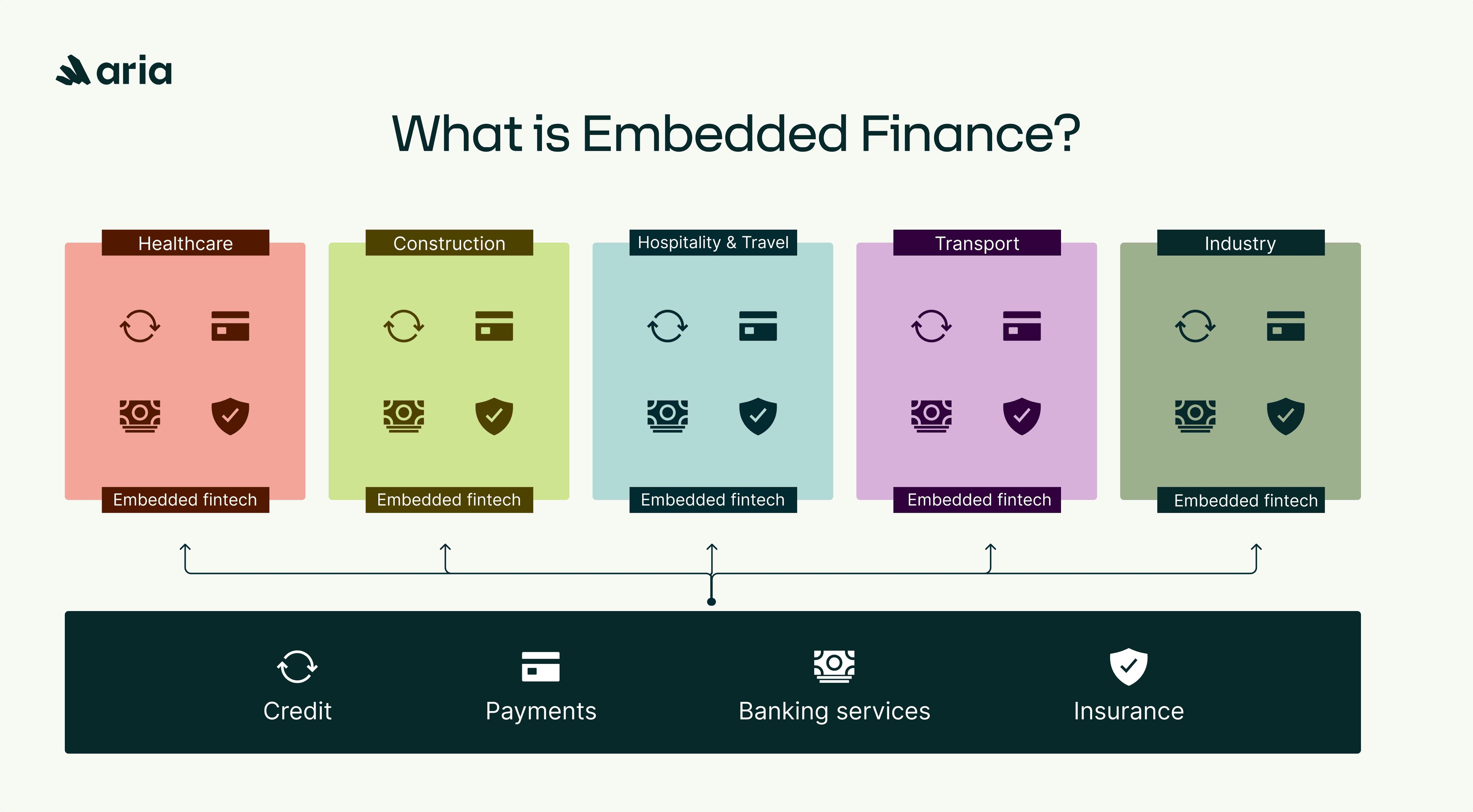What is Embedded Finance? Definition, Examples & Business Impact
From paying in one click on your favorite app to accessing credit directly from a SaaS platform, embedded finance is transforming the way financial services are delivered. In this article, we break down what embedded finance really means, how it works, and why it’s becoming a game-changer for businesses across industries.

Embedded finance isn’t just another buzzword. From SaaS to DSPs to marketplaces, more and more tech companies are turning to embedded finance to unlock growth, boost performance, and stand out in competitive markets. In this guide, we’ll walk you through what embedded finance really means, how it works, and why it’s gaining ground fast — especially in B2B.
1 – What Is Embedded Finance?
1.1 – A simple definition
Embedded finance is the seamless integration of financial services — like payments, lending, insurance, or account services — directly into non-financial digital products. Instead of sending users to a separate banking portal, your platform becomes the place where everything happens. Think about the convenience of ordering a taxi and paying in-app — that’s embedded finance at work. In a B2B context, it can mean offering payment terms, factoring, or insurance options directly within your product.
1.2 – How embedded finance works
APIs do the heavy lifting. With just a few lines of code, a marketplace or SaaS platform can offer financial services to its users.
This means companies don’t need to build or license entire financial stacks from scratch. Instead, they partner with fintech providers who offer modular, secure solutions that can be integrated quickly. The result? A better, faster, more streamlined experience for end users — and more value created by your product.
1.3 – Open banking meets embedded finance
By allowing access to user-permissioned banking data, platforms can now personalise financial services — from tailored credit decisions to instant bank transfers — without ever leaving the interface. Embedded finance takes this even further by delivering those services at the exact moment they’re needed. Together, open banking and embedded finance enable smarter, more contextual experiences.

2 – Embedded Finance: Key Use Cases
2.1 – Embedded payment
One of the most established use cases, embedded payments let users pay without leaving your platform or app. Whether it’s ordering a ride, renewing a subscription, or paying a supplier, users appreciate the simplicity and security of not having to re-enter their payment details. This ease of use not only streamlines the customer journey but also increases conversion rates.
2.2 – Embedded insurance
Insurance might not sound exciting, but embedding it where it matters most — at checkout, during a booking, or within a user workflow — changes the game. Users can opt in with a click, without visiting a separate insurer’s site or filling in extra forms. This improves trust, satisfaction, and overall adoption of optional services.
2.3 – Embedded banking
Banking services — like issuing a debit card, opening a current account, or granting a loan — can now be embedded directly into digital platforms. For example, a freelancer management tool might offer users a business account and payment card, without needing to redirect them elsewhere. This is especially powerful for platforms serving SMEs or independent workers.
2.4 – Embedded invoice financing (Aria’s expertise)
In many B2B sectors, payment terms are long — but suppliers and freelancers often need to get paid fast. Embedded invoice financing solves this gap. It allows users to request early payment for an invoice, right inside the platform they already use. Platforms like Aria make this possible via API, helping both the supplier (who gets paid instantly) and the platform (which becomes more valuable and trustworthy).
3 – What problems does embedded finance solve?
3.1 – Make your product indispensable
When users can manage their finances directly within your platform, it becomes more than just a tool — it becomes central to how they operate. Embedded finance strengthens stickiness by increasing usage frequency and reducing reliance on third-party tools. You’re not just offering features; you’re creating a daily habit.
3.2 – Boost loyalty
Financial services that solve real pain points — like delayed payments or a lack of insurance — build trust and loyalty. They give users tangible reasons to stay. On top of that, these features reinforce your brand as reliable and user-centric, which helps reduce churn and foster long-term engagement.
3.3 – Fuel growth and revenue
Beyond improving UX, embedded finance can generate entirely new revenue streams. Whether through transaction fees, financing margins, or partner incentives, platforms gain financially from offering these services. Plus, they improve KPIs like GMV (gross merchandise value) and LTV (lifetime value), directly supporting sustainable business growth.
4 – Who benefits most from embedded finance?
4.1 – Product & tech teams
Developers and product managers are often wary of adding complexity — but embedded finance doesn’t have to be hard. With modular APIs and fintech partners like Aria, it’s possible to launch quickly without disrupting existing roadmaps. Well-documented integrations ensure low friction and high scalability.
4.2 – Revenue teams
For sales and GTM teams, embedded finance unlocks a compelling sales argument: faster payments, better terms, added value. It can tip the balance in a competitive pitch or help upsell existing clients. In fast-moving markets, these differentiators matter.
4.3 – Finance leaders
CFOs and finance managers benefit from greater control over cash flow, fewer disputes, and smoother supplier relations. Embedded invoice financing, in particular, helps balance liquidity needs and reduce reliance on traditional loans — all while respecting regulatory payment terms.
4.4 – Procurement teams
When you embed financing directly into your ERP or P2P system, procurement teams gain real leverage. Suppliers get paid faster, without changing your payment terms — which means stronger relationships, fewer delays, and smoother negotiations. Everyone wins.
5 – Why Aria?
5.1 – We focus on what matters most: cash flow
Late payments hurt everyone — and we’ve built Aria to fix that. Our invoice financing solution helps platforms advance cash to suppliers instantly, even if the end customer pays 30 or 60 days later. That’s good for supplier loyalty, operational fluidity, and peace of mind.
5.2 – Built for developers, loved by teams
Our tech is designed to fit into yours. We offer robust, secure APIs with flexible authentication, webhook notifications, and granular controls. Documentation is clear and updated regularly — so your developers won’t have to guess.
5.3 – Scale without the stress
Embedded finance isn’t just for large enterprises. Whether you’re a scaling startup or an established platform, Aria supports your growth. From pilot phase to high-volume operations, we help you embed financing in a way that’s sustainable, reliable, and impactful.
6 – FAQ: What else should I know about embedded finance?
Who is embedded finance for?
Any business that manages transactions between buyers and suppliers can benefit — especially platforms like SaaS, DSPs, marketplaces, ERPs or P2P tools. It’s particularly useful for companies with long payment cycles or cash flow constraints.
Does embedded finance replace my current tools?
No. It enhances them. With APIs, you can integrate financial features into your existing platform, ERP, or workflow — without major disruption.
How do I know if my users need embedded finance?
If your suppliers ask for faster payments, or your users juggle multiple tools for payments, credit, or insurance — chances are they’d welcome embedded finance. It simplifies their experience and builds loyalty.


